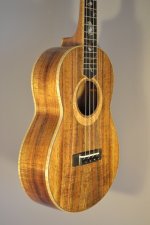Masonguitars
Active member
Here are some shots of my first baritone ukulele--all koa body with maple binding and sound hole ring, and birds with flowering tree inlay on the neck and peg head. The design was inspired by one of Chuck Moores ukes. His site is a wealth of inspiration for me. Thank you Chuck. I hope you believe that imitation is the most sincere form of flattery.
The uke has a 20" scale, and rather than stringing it for guitar pitch, I strung it tuned f/bflat/d/g (a tone below normal high uke tuning). At that pitch, it still sounds like a ukulele, but with the bigger body and longer string length, the instrument actually has significantly more tone and resonance as you play up the fingerboard. It's also more comfortable for the left hand playing up the neck--for me at least. My wife and I like to play jazz standards and she loves singing to this uke because it has enough sound to support her and because it brings the pitch down a step to a more comfortable range for her.




The uke has a 20" scale, and rather than stringing it for guitar pitch, I strung it tuned f/bflat/d/g (a tone below normal high uke tuning). At that pitch, it still sounds like a ukulele, but with the bigger body and longer string length, the instrument actually has significantly more tone and resonance as you play up the fingerboard. It's also more comfortable for the left hand playing up the neck--for me at least. My wife and I like to play jazz standards and she loves singing to this uke because it has enough sound to support her and because it brings the pitch down a step to a more comfortable range for her.







